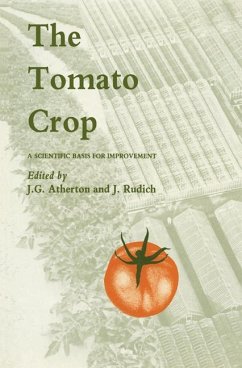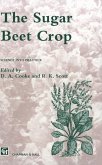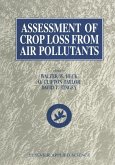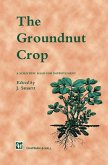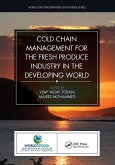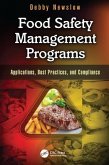The Tomato Crop
A scientific basis for improvement
Herausgegeben:Atherton, J.; Rudich, J.
The Tomato Crop
A scientific basis for improvement
Herausgegeben:Atherton, J.; Rudich, J.
- Broschiertes Buch
- Merkliste
- Auf die Merkliste
- Bewerten Bewerten
- Teilen
- Produkt teilen
- Produkterinnerung
- Produkterinnerung
The tomato is commercially important throughout the world both for the fresh fruit market and the processed food industries. It is grown in a wide range of climates in the field, under protection in plastic greenhouses and in heated glasshouses. Genetic, physiological and pathological investigations frequently adopt the tomato plant as a convenient subject. Hitherto, much of the information on tomatoes has been fragmented: tomatoes grown in the field and under protection have been considered separately and the more fundamental findings from research have often failed to reach those involved…mehr
Andere Kunden interessierten sich auch für
![The Sugar Beet Crop The Sugar Beet Crop]() D. A. CookeThe Sugar Beet Crop116,99 €
D. A. CookeThe Sugar Beet Crop116,99 €![Bananas and Plantains Bananas and Plantains]() Bananas and Plantains229,99 €
Bananas and Plantains229,99 €![Assessment of Crop Loss From Air Pollutants Assessment of Crop Loss From Air Pollutants]() Assessment of Crop Loss From Air Pollutants39,99 €
Assessment of Crop Loss From Air Pollutants39,99 €![The Groundnut Crop The Groundnut Crop]() The Groundnut Crop224,99 €
The Groundnut Crop224,99 €![Cold Chain Management for the Fresh Produce Industry in the Developing World Cold Chain Management for the Fresh Produce Industry in the Developing World]() Cold Chain Management for the Fresh Produce Industry in the Developing World65,99 €
Cold Chain Management for the Fresh Produce Industry in the Developing World65,99 €![Food Safety Management Programs Food Safety Management Programs]() Debby NewslowFood Safety Management Programs58,99 €
Debby NewslowFood Safety Management Programs58,99 €![Proceedings of the Fourth International Symposium on Cyclodextrins Proceedings of the Fourth International Symposium on Cyclodextrins]() Proceedings of the Fourth International Symposium on Cyclodextrins229,99 €
Proceedings of the Fourth International Symposium on Cyclodextrins229,99 €-
-
-
The tomato is commercially important throughout the world both for the fresh fruit market and the processed food industries. It is grown in a wide range of climates in the field, under protection in plastic greenhouses and in heated glasshouses. Genetic, physiological and pathological investigations frequently adopt the tomato plant as a convenient subject. Hitherto, much of the information on tomatoes has been fragmented: tomatoes grown in the field and under protection have been considered separately and the more fundamental findings from research have often failed to reach those involved directly or indirectly in commercial crop production. Similarly, the research scientist is often unaware of the problems of commercial crop production and the possible relevance of his work to the crop. This book is an attempt to rectify that situation. By giving a thorough scientific review of all factors influencing tomato production systems, it is hoped that this book will prove useful to students, researchers and commercial producers alike. It gives the basis for the develop ment of improved cultivars, the formulation of strategies for managing pest, disease and disorder problems and the production of high yields of good quality fruit as well as suggesting important areas for scientific initiatives. The extensive bibliographies provide a comprehensive database for tomato researchers. Such a vast subject could not be covered with authority by anyone author.
Hinweis: Dieser Artikel kann nur an eine deutsche Lieferadresse ausgeliefert werden.
Hinweis: Dieser Artikel kann nur an eine deutsche Lieferadresse ausgeliefert werden.
Produktdetails
- Produktdetails
- World Crop Series
- Verlag: Springer / Springer Netherlands
- Artikelnr. des Verlages: 978-94-010-7910-5
- 1986
- Seitenzahl: 680
- Erscheinungstermin: 13. November 2013
- Englisch
- Abmessung: 235mm x 155mm x 37mm
- Gewicht: 938g
- ISBN-13: 9789401079105
- ISBN-10: 9401079102
- Artikelnr.: 39916126
- Herstellerkennzeichnung Die Herstellerinformationen sind derzeit nicht verfügbar.
- World Crop Series
- Verlag: Springer / Springer Netherlands
- Artikelnr. des Verlages: 978-94-010-7910-5
- 1986
- Seitenzahl: 680
- Erscheinungstermin: 13. November 2013
- Englisch
- Abmessung: 235mm x 155mm x 37mm
- Gewicht: 938g
- ISBN-13: 9789401079105
- ISBN-10: 9401079102
- Artikelnr.: 39916126
- Herstellerkennzeichnung Die Herstellerinformationen sind derzeit nicht verfügbar.
1 Biosystematics of the tomato.- 1.1 Introduction.- 1.2 Taxonomic status of the tomato within the family Solanaceae.- 1.3 Composition of the genus Lycopersicon.- 1.4 The problem of Solanum (or Lycopersicon) pennellii.- 1.5 Other closely related Solanum species.- References.- 2 Genetics and Breeding.- 2.1 Introduction.- 2.2 Mutants.- 2.3 Cytogenetics.- 2.4 Linkage.- 2.5 Mutation.- 2.6 Biochemical and molecular genetics.- 2.7 Developmental and physiological genetics.- 2.8 Interspecific and intergeneric hybridization.- 2.9 History of tomato breeding.- 2.10 Resistance to disease.- 2.11 Resistance to nematodes (Meloidogyne spp.).- 2.12 Resistance to insects.- 2.13 Tolerance of stress.- 2.14 Nutrient use efficiency.- 2.15 Parthenocarpy.- 2.16 Male sterility.- 2.17 Fruit quality.- 2.18 Cultivars for machine harvest.- 2.19 Cultivars for greenhouse production.- 2.20 Seed production.- 2.21 Seed crop husbandry.- References.- 3 Germination and vegetative development.- 3.1 Introduction.- 3.2 Germination.- 3.3 Vegetative development.- 3.4 Conclusions.- 3.5 Acknowledgements.- 3.6 Abbreviations.- 3.6 Symbols used in text.- References.- 4 Flowering.- 4.1 Introduction.- 4.2 Significance of flowering in tomato production.- 4.3 Floral morphology.- 4.4 Growth and flowering of determinate and indeterminate cultivars.- 4.5 Shoot environment and flowering.- 4.6 Root environment and flowering.- 4.7 Plant growth regulators and flowering.- 4.8 Growth correlations and flowering.- 4.9 Concluding remarks.- 4.10 Acknowledgements.- References.- 5 Fruit development.- 5.1 Significance of fruit development in tomato production.- 5.2 Processes of pollination and fertilization.- 5.3 Morphology and anatomy of fruits.- 5.4 Factors affecting the rate of fruit development.- 5.5 Assimilate distribution in fruiting plants.- 5.6 Growth regulators and parthenocarpic fruit formation.- References.- 6 Fruit ripening and quality.- 6.1 Introduction.- 6.2 Physiology and biochemistry of ripening.- 6.3 Quality components and evaluation procedures.- 6.4 Pre-harvest factors influencing quality.- 6.5 Post-harvest factors influencing quality.- References.- 7 Mineral nutrition.- 7.1 Introduction.- 7.2 Growth and crop responses to nutrients.- 7.3 Factors affecting responses to nutrients.- 7.4 Nutrient uptake and distribution.- 7.5 Nutritional disorders.- 7.6 Estimating nutrient requirements.- 7.7 Future developments.- References.- 8 Water economy.- 8.1 Introduction.- 8.2 Water potential.- 8.3 Cell and plant growth.- 8.4 Development of the root system.- 8.5 Turgor maintenance by osmotic adjustment.- 8.6 The importance of osmotic adjustment.- 8.7 Stomatal behaviour.- 8.8 The role of abscisic acid and other hormones in water stress.- 8.9 Carbon metabolism and translocation of assimilates.- 8.10 Nitrogen metabolism and protein synthesis.- 8.11 Adaptation to water stress.- 8.12 Effects of salinity.- 8.13 Responses to waterlogging.- 8.14 Interspecific differences in drought resistance.- 8.15 Quantitative indices of water stress and irrigation planning.- 8.16 Effects of water tension on the crop.- 8.17 Water economy and fruit quality.- References.- 9 Disorders.- 9.1 Introduction.- 9.2 Rogues.- 9.3 Silvering.- 9.4 Leaf distortion.- 9.5 Silvering and leaf distortion on seedlings.- 9.6 Other chimerical disorders.- 9.7 Cytoplasmic inheritance in the tomato.- 9.8 Triploids.- 9.9 Non-genetic disorders.- 9.10 Damage from aerial pollutants.- 9.11 Other chemically induced disorders.- 9.12 Disorders related to flooding and water stress.- References.- 10 Pests.- 10.1 Introduction.- 10.2 Pest damage.- 10.3 Geographical distribution of pests.- 10.4 The biology and control of some important pests.- 10.5 Pest management.- References.- 11 Diseases.- 11.1 Introduction.- 11.2 Disease development in protected and field crops.- 11.3 Major tomato diseases of Europe. USA and the Middle East.- 11.4 Disease control strategy.- References.- 12 Weed control.- 12.1 Introduction.- 12.2 Weed biology.- 12.3 Field management for weed control.- 12.4 Herbicides.- 12.5 General conclusions.- References.- 13 Field crop management.- 13.1 Introduction.- 13.2 Timing of operations.- 13.3 Timing of fruit production.- 13.4 Land preparation.- 13.5 Pre-planting water, fertilizer and chimerical treatments.- 13.6 Seedbed conditions.- 13.7 Crop spacing and arrangement.- 13.8 Transplant production.- 13.9 Fluid drilling.- 13.10 Pre-sowing salt treatments and osmoconditioning.- 13.11 Plug mix planting.- 13.12 Fertilizers.- 13.13 Soil mulching.- 13.14 Irrigation.- 13.15 Training and trimming field tomatoes.- 13.16 Field production under partial protection with plastic tunnels.- 13.17 Fruit set.- 13.18 Enhancement of fruit ripening.- 13.19 Harvest and handling.- References.- 14 The future of the field crop.- 14.1 Recent trends in production and consumption in the USA.- 14.2 Cultivars for the future.- 14.3 Cultural practices.- 14.4 Harvesting.- 14.5 Conclusions.- References.- 15 Glasshouse crop production.- 15.1 Introduction.- 15.2 Economics.- 15.3 Glasshouse structure and equipment.- 15.4 Planting and cropping schedules.- 15.5 Substrates.- 15.6 Nutrition and irrigation.- 15.7 Varieties.- 15.8 Crop spacing and arrangement.- 15.9 Transplant production.- 15.10 Training and management systems.- 15.11 Environmental factors.- 15.12 Harvest of tomato fruits.- 15.13 Integrated pest management in glasshouse tomatoes.- References.- 16 An economic consideration of the future for glasshouse tomatoes.- 16.1 Introduction.- 16.2 Current profitability of heated tomato crops.- 16.3 Short-term options for glasshouse tomato growers.- 16.4 Some future scenarios.- 16.5 Conclusions.- 16.6 Towards the year 2000.- References.
1 Biosystematics of the tomato.- 1.1 Introduction.- 1.2 Taxonomic status of the tomato within the family Solanaceae.- 1.3 Composition of the genus Lycopersicon.- 1.4 The problem of Solanum (or Lycopersicon) pennellii.- 1.5 Other closely related Solanum species.- References.- 2 Genetics and Breeding.- 2.1 Introduction.- 2.2 Mutants.- 2.3 Cytogenetics.- 2.4 Linkage.- 2.5 Mutation.- 2.6 Biochemical and molecular genetics.- 2.7 Developmental and physiological genetics.- 2.8 Interspecific and intergeneric hybridization.- 2.9 History of tomato breeding.- 2.10 Resistance to disease.- 2.11 Resistance to nematodes (Meloidogyne spp.).- 2.12 Resistance to insects.- 2.13 Tolerance of stress.- 2.14 Nutrient use efficiency.- 2.15 Parthenocarpy.- 2.16 Male sterility.- 2.17 Fruit quality.- 2.18 Cultivars for machine harvest.- 2.19 Cultivars for greenhouse production.- 2.20 Seed production.- 2.21 Seed crop husbandry.- References.- 3 Germination and vegetative development.- 3.1 Introduction.- 3.2 Germination.- 3.3 Vegetative development.- 3.4 Conclusions.- 3.5 Acknowledgements.- 3.6 Abbreviations.- 3.6 Symbols used in text.- References.- 4 Flowering.- 4.1 Introduction.- 4.2 Significance of flowering in tomato production.- 4.3 Floral morphology.- 4.4 Growth and flowering of determinate and indeterminate cultivars.- 4.5 Shoot environment and flowering.- 4.6 Root environment and flowering.- 4.7 Plant growth regulators and flowering.- 4.8 Growth correlations and flowering.- 4.9 Concluding remarks.- 4.10 Acknowledgements.- References.- 5 Fruit development.- 5.1 Significance of fruit development in tomato production.- 5.2 Processes of pollination and fertilization.- 5.3 Morphology and anatomy of fruits.- 5.4 Factors affecting the rate of fruit development.- 5.5 Assimilate distribution in fruiting plants.- 5.6 Growth regulators and parthenocarpic fruit formation.- References.- 6 Fruit ripening and quality.- 6.1 Introduction.- 6.2 Physiology and biochemistry of ripening.- 6.3 Quality components and evaluation procedures.- 6.4 Pre-harvest factors influencing quality.- 6.5 Post-harvest factors influencing quality.- References.- 7 Mineral nutrition.- 7.1 Introduction.- 7.2 Growth and crop responses to nutrients.- 7.3 Factors affecting responses to nutrients.- 7.4 Nutrient uptake and distribution.- 7.5 Nutritional disorders.- 7.6 Estimating nutrient requirements.- 7.7 Future developments.- References.- 8 Water economy.- 8.1 Introduction.- 8.2 Water potential.- 8.3 Cell and plant growth.- 8.4 Development of the root system.- 8.5 Turgor maintenance by osmotic adjustment.- 8.6 The importance of osmotic adjustment.- 8.7 Stomatal behaviour.- 8.8 The role of abscisic acid and other hormones in water stress.- 8.9 Carbon metabolism and translocation of assimilates.- 8.10 Nitrogen metabolism and protein synthesis.- 8.11 Adaptation to water stress.- 8.12 Effects of salinity.- 8.13 Responses to waterlogging.- 8.14 Interspecific differences in drought resistance.- 8.15 Quantitative indices of water stress and irrigation planning.- 8.16 Effects of water tension on the crop.- 8.17 Water economy and fruit quality.- References.- 9 Disorders.- 9.1 Introduction.- 9.2 Rogues.- 9.3 Silvering.- 9.4 Leaf distortion.- 9.5 Silvering and leaf distortion on seedlings.- 9.6 Other chimerical disorders.- 9.7 Cytoplasmic inheritance in the tomato.- 9.8 Triploids.- 9.9 Non-genetic disorders.- 9.10 Damage from aerial pollutants.- 9.11 Other chemically induced disorders.- 9.12 Disorders related to flooding and water stress.- References.- 10 Pests.- 10.1 Introduction.- 10.2 Pest damage.- 10.3 Geographical distribution of pests.- 10.4 The biology and control of some important pests.- 10.5 Pest management.- References.- 11 Diseases.- 11.1 Introduction.- 11.2 Disease development in protected and field crops.- 11.3 Major tomato diseases of Europe. USA and the Middle East.- 11.4 Disease control strategy.- References.- 12 Weed control.- 12.1 Introduction.- 12.2 Weed biology.- 12.3 Field management for weed control.- 12.4 Herbicides.- 12.5 General conclusions.- References.- 13 Field crop management.- 13.1 Introduction.- 13.2 Timing of operations.- 13.3 Timing of fruit production.- 13.4 Land preparation.- 13.5 Pre-planting water, fertilizer and chimerical treatments.- 13.6 Seedbed conditions.- 13.7 Crop spacing and arrangement.- 13.8 Transplant production.- 13.9 Fluid drilling.- 13.10 Pre-sowing salt treatments and osmoconditioning.- 13.11 Plug mix planting.- 13.12 Fertilizers.- 13.13 Soil mulching.- 13.14 Irrigation.- 13.15 Training and trimming field tomatoes.- 13.16 Field production under partial protection with plastic tunnels.- 13.17 Fruit set.- 13.18 Enhancement of fruit ripening.- 13.19 Harvest and handling.- References.- 14 The future of the field crop.- 14.1 Recent trends in production and consumption in the USA.- 14.2 Cultivars for the future.- 14.3 Cultural practices.- 14.4 Harvesting.- 14.5 Conclusions.- References.- 15 Glasshouse crop production.- 15.1 Introduction.- 15.2 Economics.- 15.3 Glasshouse structure and equipment.- 15.4 Planting and cropping schedules.- 15.5 Substrates.- 15.6 Nutrition and irrigation.- 15.7 Varieties.- 15.8 Crop spacing and arrangement.- 15.9 Transplant production.- 15.10 Training and management systems.- 15.11 Environmental factors.- 15.12 Harvest of tomato fruits.- 15.13 Integrated pest management in glasshouse tomatoes.- References.- 16 An economic consideration of the future for glasshouse tomatoes.- 16.1 Introduction.- 16.2 Current profitability of heated tomato crops.- 16.3 Short-term options for glasshouse tomato growers.- 16.4 Some future scenarios.- 16.5 Conclusions.- 16.6 Towards the year 2000.- References.

